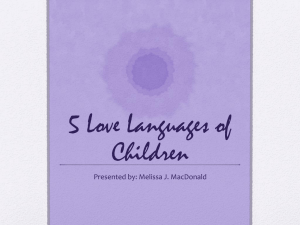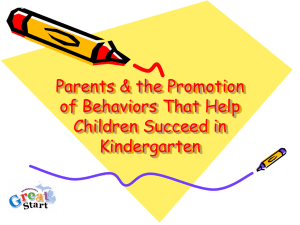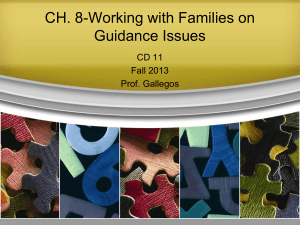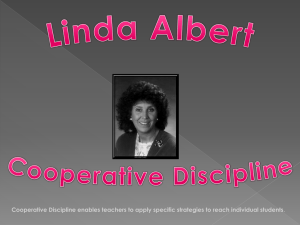The 5 Love Languages of Children
advertisement
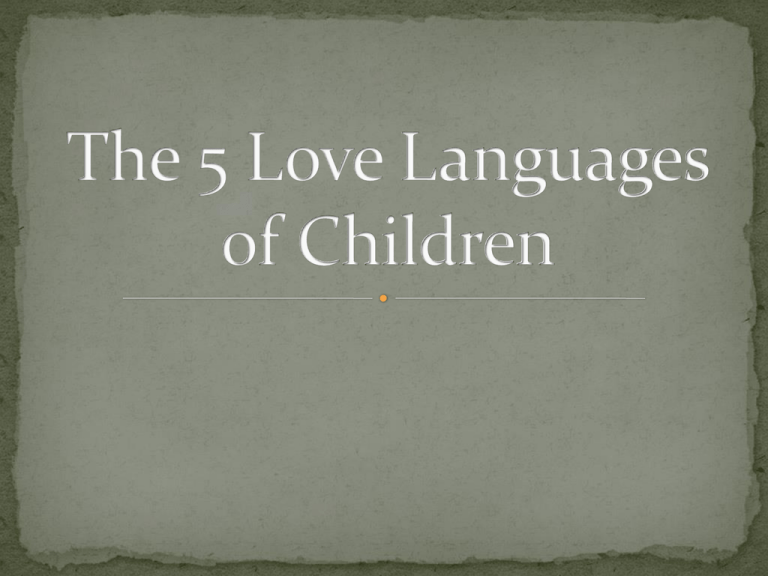
Physical touch is the easiest love language to use unconditionally, because parents need o special occasion or excuse to make physical contact. They have almost constant opportunity to transfer love to the heart of a child with touch The language of physical touch is not confined to a hug or a kiss but includes any kind of physical contact. Even when they are busy, parents can often gently touch a child on the back, arm, or shoulder. Though some parents are quite demonstrative, others almost try to avoid touching their children. Often this limited physical touching occurs because parents simply do not realize their pattern or do not know how to change it. Many are glad to learn how they can show love in this most basic way. Physical touch is on of love’s strongest voices! All children need to be touched, and wise parents in many cultures recognize the importance of touching their children. They also recognize the need to have their children receive the tender touch of other significant adults, such as grandparents. Touch through the growing years Infants & Toddlers • Our children need plenty of touches during their first few years • As a baby grows and becomes more active, the need for touch does not lessen • Children need many meaningful touches every day, and parents should make every effort to provide these expressions of love. Touch through the growing years School-age children • When your child starts school, he still has a strong need for physical touch. • Home should be a haven, the place where love is secure. • ALL children (boys and girls) need physical contact throughout their childhood and adolescence. Touch through the growing years From Tweens to Teens • During your child’s grade school years, it is essential to remember you are preparing your child for one of the most difficult parts of childhood – adolescence. • Continue to fuel their tanks with love, even when they may not give you signs of their need. Touch through the growing years Your Teenager and Touch • When your child reaches the teen years , it is important that you show your love in positive ways and also at the right times and places • Remember, you are a role model for your children; they will be watching the way you practice physical touch. One way you can tell if they are following your example is to watch their use of physical touch. When Physical Touch is your child’s primary Love Language Physical touch will communicate more deeply than will the words “I Love You” or giving a present, fixing a bicycle, or spending time with them. Of course, they receive love in all the languages, but for them the one with the clearest and loudest voice is physical touch. Without hugs, kisses, pats on the back, and other physical expressions of love, their love tanks remain less than full. When you greet or say good-bye gather them into your arms. Let your children hold or cuddle a soft item (blanket, stuffed animal) Hug and kiss your child every day Stroke your child’s hair or rub their back when they tell you about a difficult day or are upset After disciplining your child, take a moment to give them a hug Snuggle closely on the couch when watching a movie Give high fives or similar congratulations Play games that require physical touch Have tickle fights Hold hands during family prayer In communicating love, words are powerful. Words of affection and endearment, words of praise and encouragement, words that give positive guidance all say, “I care about you.” Some children feel their greatest sense of love in expressions that affirm them these expressions need not be the words “I love you” as we will see Understanding “I Love You” Long before they can understand the meanings of words, children receive emotional messages. Because children tend to think concretely, we need to help them understand what we mean when we express our love. The words “I love you” take on greater meaning when the child can associate them with your affectionate feelings, and often mean physical closeness The right kind of praise Affection and love mean expressing appreciation for the very being of a child, for those characteristics and abilities that are part of the total package of the person. In contrast, we express praise for what the child does, either in achievements or behavior or conscious attitudes. The power of encouragement The word encourage means “to instill courage”. We are seeking to give children the courage to attempt more. Words such as these give a child that added inner motivation to go against what might be a natural desire The power of encouragement The greatest enemy to encouraging our children is anger. Right message, wrong manner Encouraging words are most effective when they are focused on a specific effort your child has made. Ask yourself this question: are my children receiving positive and loving guidance? Loving guidance always has the child’s best interest in mind. Words of guidance must be given in a positive way. Put post-it notes in their lunchbox with encouraging words Make a habit of mentioning something specific you’ve seen that highlights your child’s accomplishments Ask what your child wants to be when they grow up and encourage them in ways that help them pursue those dreams Send your child a text message telling them how much they mean to you If you are artistic create a drawing, painting, poem, song that shows how much you love your child Take a picture or other creation your child has made and frame it with a note of why it means so much to you Create a special name of affection for your child that is only used between you two When a child makes a mistake try doing something helpful, by telling them you knew of their good intentions Quality time is focused, undivided attention. It’s easier to give physical touch and words of affirmation than quality time. Few of us have enough hours in the day to get everything done as it is; giving a child quality time may mean that we have to give up something else. When a child’s love tank is empty and attention is the only thing that will fill it, that child will go to almost any length to get what she needs. “He does things with me” The most important factor in quality time is not the event itself but that you are doing something together, being together. Finding time to be alone with each child is not easy, and yet it is essential. Positive eye contact Looking in your child’s eyes with care is a powerful way to convey love from your heart to the heart of your child. You want to keep your child’s emotional tank full, and a key way to do this is through proper use of eye contact. Sharing thoughts and feelings Quality time not only means doing things together, but it is a means of knowing your child better. When a parent shows a child how to throw a football or make a cake, he/she often creates an environment in which the parent and child can talk about more important issues Quality conversations This kind of “real” conversation communicates deeply to a child on an emotional level. Children NEVER out grow a need for quality conversation with parents and other adults. Such sharing of thoughts and feelings is the fabric of which life is made. Planning for quality time You need to spend time and effort preparing for family quality time, otherwise IT WON’T HAPPEN! Mealtime Overnight trips Driving to/from activities Prepare YOURSELF for these times Instead of waiting until your chores are done before spending time with your child, include them in your daily chores – may take more time Stop what you are doing and make eye contact with your child when they tell you something important Fix a snack to enjoy together Find silly things to laugh about and laugh about them a lot Ask specific questions about your child’s day that don’t have a yes or no answer Schedule a specific “date time” with each of your children individually. Put it on your calendar and don’t allow anything to take its place Share more meals together as a family Spend time doing “homework” or other projects together On a rainy day, sit in the same room and read quietly, each of you with your own book or magazine The giving and receiving of gifts can be a powerful expression of love, as the time they are given and often extending into later years. The child’s emotional love tank needs to be kept filled in order for the gift to express heartfelt love. This means that parents will use a combination of physical touch, words of affirmation, quality time and service to keep the love tank full. The grace of giving Giving and receiving gifts as a way to express love is a universal phenomenon. Sincere giving Misinterpretation of a gift Make the most of giving The grace of giving has little to do with the size and cost of the gift. It has everything to do with love. Do not let advertisers (or society) determine what you buy for your children. When giving is abused Be careful! Guidelines for giving Gifts should be an expression of genuine love Involve your children in the selection of some of their gifts Remember not all gifts come from the store Select presents that fit the interest of your child Carry snacks or small candies you can give out as a special “treat” Make a meal you know your child likes, or go to their favorite restaurant Start a collection of gift boxes/bags that can be used to package even the most simple gift When away from home mail/bring back a small gift Be on the lookout for personalized gifts with your child’s name on them. Save them for a rainy or difficult day as an encouraging surprise Give your child a “song” either one you make up or a special song you select that reminds you of them Hide a small gift in your child’s lunchbox Buy or make your child a special ring or necklace to wear that is just from you Acts of service are physically and emotionally demanding. Who do I serve? What is best? Manipulate Model What should a child do when Age appropriate. You should do what they cannot do them self We serve our children, but as they are ready we teach them to serve themselves and then others Service or slavery? Loving service is not slavery. Slavery is imposed from the outside and is done with reluctance. Loving service is a gift, not a necessity, and is done freely, not under coercion. Ultimate purpose of service Help children emerge as mature adults who are able to give love to others through acts of service. Teaching by example We must be careful never to show conditional love in our acts of service – our children are watching! Help you child practice for their sports teams Sit down and help your child if they’re having computer problems Instead of just telling your younger child to go to bed, carry them and tuck them in Help your child select the clothes they will wear the next day Wake up early and make a special breakfast When running late, help your child finish up what they are doing instead of just telling them to hurry When you child is sick, go the extra step by setting up their favorite movie, reading them stories, or buying them a book in their favorite series Connect your child with one of your friends or family members who can help them in an area of interest (technology, soccer, piano, etc.) Start a birthday dinner tradition where you make your child any meal they like Observe how your child expresses Love to you Observe how your child expresses Love to others Listen to what your child requests most often Notice what your child most frequently complains about Give your child a choice between two options Discipline is NOT a negative word Discipline comes from a Greek word which means “to train” Discipline involves guiding a child from infancy to adulthood You train your child in mind and character to become a self-controlled and constructive member of your home and community You will employ guidance by example, modeling, verbal instruction, written request, teaching and preaching right behavior, correcting wrong behavior, providing learning experiences, and much MORE Punishment is also one of these means and DOES have its place, but in many homes punishment is greatly overused. In many homes, parents assume that discipline and punishment are synonymous. Discipline helps to establishes rules, boundaries, and guidelines for behavior Parents play the MOST important role in the discipline of their children Discipline varies greatly from family to family, and even the “experts” disagree about the “best” way to discipline Remember Love looks out for the interest of another; so does discipline The more a child feels loved, the easier it is to discipline that child It is crucial that you love your child unconditionally. Every child needs this to keep his/her love tank full. Then you will be able to discipline with the best possible results. When a child misbehaves The thing we must recognize is the child asking “do you love me?” Second we must ask, “what does my child need when she misbehaves?” Does my child feel sorry for what they have done? 5 ideas on controlling your child’s behavior Making requests Issuing commands Gentle physical manipulation Punishment Behavior modification Positive reinforcement Negative reinforcement Punishment Pay attention to your child Encourage your child’s interest Quiz


